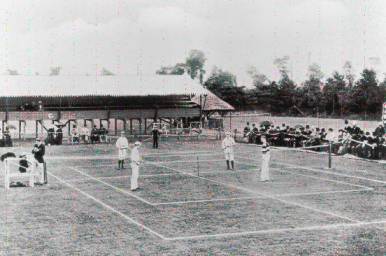
Tennis, a sport that epitomizes both grace and agility, has undergone a remarkable evolution. From its humble beginnings on the manicured lawns of 19th-century England to its current status as a global phenomenon, tennis has not just survived the test of time; it has thrived.
This blog explores the captivating journey of tennis, a sport that has captivated millions of fans and players worldwide, and also led to a significant interest in betting on the tennis matches. The addition of this dimension has not only increased viewership but also added an extra layer of excitement and engagement for fans around the globe.
The Early Days: Lawn Tennis Takes Root
The history of tennis is a fascinating journey through time, reflecting social changes and technological advancements. But to truly appreciate this sport’s global appeal, one must delve into its earliest days when lawn tennis first took root.
Origins in Victorian England
The origins of lawn tennis, a sport beloved worldwide, trace back to the Victorian era in England, a period marked by its distinct cultural and social ethos. During the mid-19th century, Major Walter Clopton Wingfield conceptualized and popularized lawn tennis, adapting it from older racket sports and setting its foundational rules in 1873. Wingfield’s version was designed to suit the expansive lawns of English estates, making it an ideal pastime for the upper classes.
This new sport quickly became a fashionable activity, intertwined with the social gatherings of Victorian high society. The elegance and leisurely pace of the game were reflective of the era’s genteel values. In these early days, lawn tennis was more than a mere game; it was a social event, a reflection of the refined lifestyle of Victorian England, and a precursor to the dynamic global sport it would eventually become.
A Game of Leisure and Social Gatherings
In the early days, lawn tennis was more than a game – it was a popular activity for rich people to enjoy and socialize. In England’s beautiful gardens, tennis courts were places where high society would meet and have fun. Both men and women, dressed in their best clothes, played tennis not just to show their skill but also their good manners.
Their clothes were fancy but not easy to move in, with women wearing long dresses and men in trousers and shirts. This made playing tennis a bit harder. Back then, tennis was less about winning and more about getting to know each other, with the sound of the ball being hit acting as background noise to conversations and making new friends.
This early version of tennis was important because it helped shape the way the game is now – still bringing people together and being a part of social gatherings.
The First Tennis Clubs and Tournaments

The start of the first tennis clubs and tournaments was a big change for tennis. It went from being just for fun to a serious sport with rules. The All England Croquet Club in Wimbledon, which started in 1868, played a big part in this change. In 1877, they held their first tennis tournament to get money for fixing their equipment.
This tournament, first called the Lawn Tennis Championship and now known as Wimbledon, is the oldest and most famous tennis tournament in the world. It helped make rules for tennis and decide what equipment to use. Clubs for tennis also started in Europe and the United States. They brought people who love tennis together and organized their own tournaments.
These early clubs were more than just places to play tennis. They were important for making tennis popular and turning it into a sport that people take seriously. This time was really important for making tennis what it is now, with professional players and big international competitions.
Evolution of Equipment and Rules
The way tennis is played has changed a lot since it started. In the beginning, players used wooden rackets and balls made by hand. But as time went on, these were replaced with better, more modern equipment. Rackets made of metal and then graphite helped players hit the ball harder and more accurately.
The tennis balls also changed. They used to be made of cloth or leather, but now they are made of a special kind of rubber that makes the game faster and more exciting. The rules of tennis have changed too. The way of scoring was made simpler, which makes it easier for people watching to understand. In the 1970s, they added a tie-break to stop matches from going on too long. These changes in the equipment and rules have made tennis more fun to watch and play, and helped it become popular all over the world.
Spreading Beyond English Borders
The spread of lawn tennis beyond the manicured English lawns marked a significant chapter in its history, transforming it from an aristocratic pastime to an international sport. As the 19th century drew to a close, British expatriates, travelers, and colonial administrators took the game with them to distant shores, introducing it to the:
- United States,
- Australia,
- and parts of Europe.
Clubs and courts began to appear in these new lands, and local adaptations of the game started to emerge. This global expansion was catalyzed by the allure of the game’s elegance and the growing fascination with outdoor sports. International tournaments soon followed, laying the groundwork for the global tennis circuit we know today. Tennis’s journey across borders is a testament to its universal appeal and adaptability, transcending cultural and geographical boundaries to become a sport cherished worldwide.
The Spread and Transformation of the Game

As the British Empire expanded, so did the reach of tennis. By the late 19th and early 20th centuries, the game had spread to the United States, Australia, and continental Europe. With its growing popularity, tennis began to shed its elitist roots. Clubs opened up to the middle class, and public courts became more common, making the game accessible to a broader audience.
The equipment also evolved. Metal racquets replaced wooden ones, and the introduction of synthetic materials led to more durable and efficient gear. These changes not only altered how the game was played but also made it more dynamic and appealing to spectators.
The Era of Championships and Global Stars
The inception of major tournaments like Wimbledon (1877), the US Open (1881), the French Open (1891), and the Australian Open (1905) marked a new era in tennis. These events brought international recognition to the sport and gave birth to the concept of professional tennis players.
The 20th century saw legends like Billie Jean King, Rod Laver, and Björn Borg, who not only dominated the sport but also became global icons. Their prowess on the court and their charisma off it contributed significantly to the popularity of tennis worldwide.
Tennis in the Modern Era
Today, tennis is a high-stakes, global sport, marked by fierce competition and significant financial rewards. Advances in technology have transformed aspects of the game, from the design of equipment to the way matches are officiated with technologies like Hawk-Eye. The physical and mental demands of the sport have also escalated, making tennis a comprehensive test of endurance, strength, strategy, and mental toughness.
Moreover, tennis has become a platform for social change. Champions like Serena Williams and Rafael Nadal have used their influence to address issues like gender equality and poverty. The sport has also become more inclusive, providing opportunities for players from diverse backgrounds.
Conclusion
The evolution of tennis from a leisurely lawn game to a global phenomenon is a testament to its enduring appeal. It has adapted to changes in society, technology, and sports science, continually reinventing itself to remain relevant. As we look to the future, it’s exciting to consider what the next chapter in the story of tennis will be. One thing is certain: the game will continue to evolve, inspire, and captivate audiences around the world.








